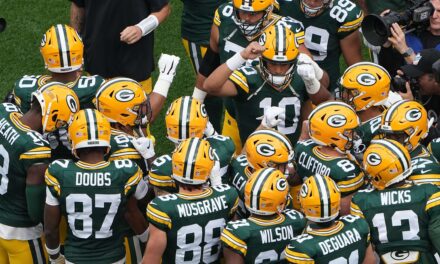This is the next in a series of articles providing an in-depth analysis of each position group on the Green Bay Packers. Today, we will examine the running backs.
Click here to see our analysis of the quarterback position.
The grades will be for each unit as a whole, but we will provide analysis of each player, their strengths and weaknesses and a quick analysis of where they stand heading into the offseason.
The Packers rushing offense ranked 18th in the league in yards gained and averaged 4.3-yards per carry over the course of the season. In 2020, the Pack ranked 8th in the NFL in rushing yards and averaged 4.8-yards per attempt.
Part of the reduction in effectiveness was due to the play of the offensive line which graded out lower in run blocking this season than they did a year ago. That will be addressed when we look at the offensive line in a forthcoming article.
Here are the grades for the Packers running backs in 2021. The marks are based on a combination of expectations and performance.
Running Backs:
The duo of Aaron Jones and A.J. Dillon gave the Packers a strong, one-two punch on the ground. While neither of them gained 1,000 yards rushing on the season, both players went over 1,000 yards from scrimmage when combining rushing and receiving yards. This is the first time this happened to a Packers running duo since Eddie Lee Ivery and Gerry Ellis did it back in 1980.
Jones has outstanding speed and is a threat to break a long run any time he touches the football. The former UTEP star missed two games and parts of others with injuries. He gained 799 yards, averaged 4.7-yards per carry and scored four rushing touchdowns.
Jones was coming off back-to-back 1,000-yard rushing seasons but with the emergence of Dillon and his assorted injuries, the Packers gave Jones the ball less often this year. He had 30 fewer carries this season and never had more than 19 carries in a game.
Jones had only one game with more than 100 yards rushing this season and that came in Week 5 in Cincinnati when he gained 103 yards on just 14 carries.
As a receiver, Jones is a dangerous weapon. He had five or more catches in five games during the regular season and added a nine-catch, 129-yard effort in the playoff game against San Francisco.
Dillon is more of a between-the-tackles runner who is tough to bring down one-on-one.
Dillon led the Packers with 803 yards and five rushing touchdowns. He averaged 4.3-yards per rush and was often called on late in games when the opposition was tired and the Packers were trying to hold a lead.
Nobody was sure if Dillon would be a good receiver in the NFL as he was rarely targeted at Boston College, but he stepped up and made 34 catches for 313 yards and two touchdowns. He made those 34 catches on just 37 targets and showed elusiveness once he got his hands on the ball in addition to reliable hands.
The Packers ability to use both runners to complement each other depending on the situation helps keep both backs fresh throughout the season.
Rookie Kylin Hill started the season as the third running back and gained 24 yards on 10 carries. He must come back from a bad knee injury suffered midseason. How quickly he can return to form will have a big effect on his future with the team. He had a strong preseason and showed some promise prior to the injury.
Patrick Taylor was moved up from the practice squad after Hill was hurt. Taylor has good size and elusiveness and gained 89 yards on 23 carries in nine games. He is also a good receiver and has more size than Hill. Taylor had to overcome injuries that cost him the entire 2020 season. He scored his first NFL touchdown in the season finale against the Lions.
The running backs were good although the offensive line blocking was not as strong in 2021 as it was the previous season.
Grade: B+
Follow Gil Martin on Twitter @GilPackers
Click here for more great Packers coverage
Visit my Web site for all things Gil Martin


